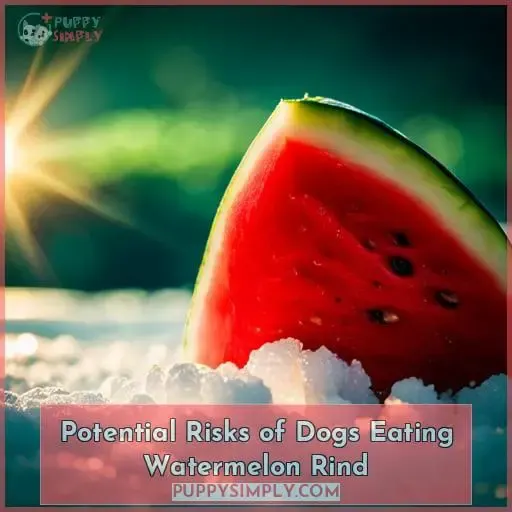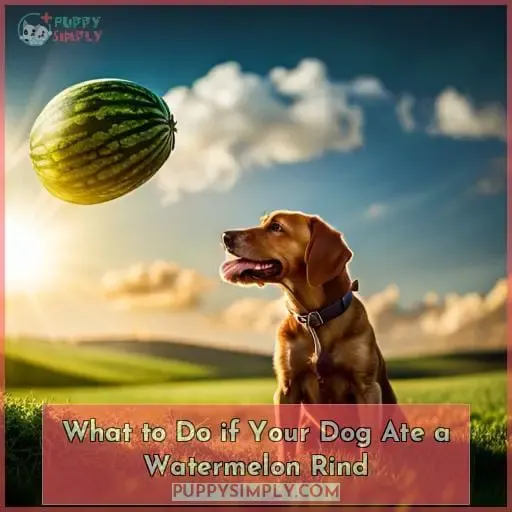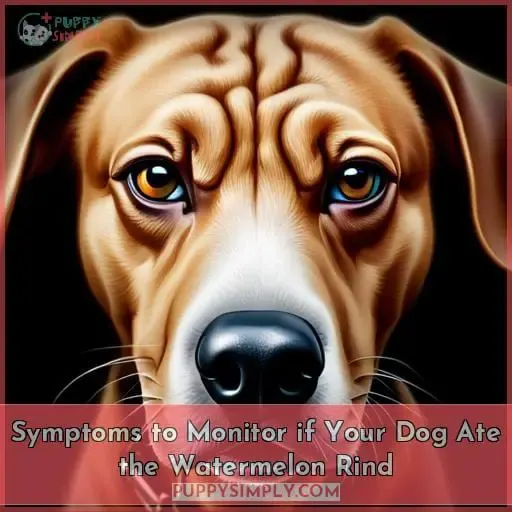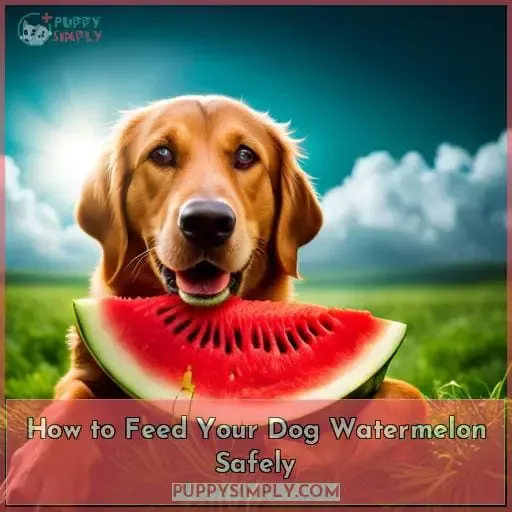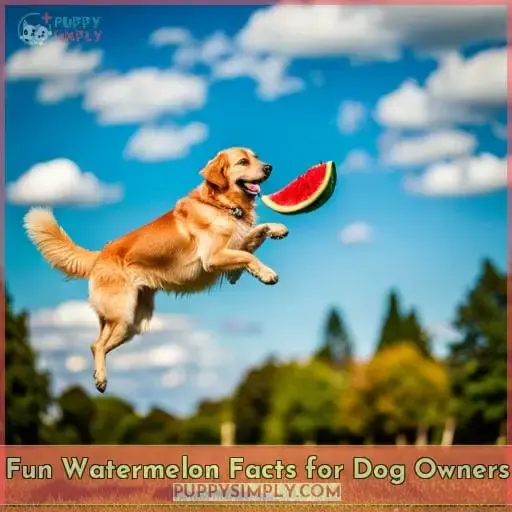This site is supported by our readers. We may earn a commission, at no cost to you, if you purchase through links.
 Are you wondering if your pup can eat the outside of a watermelon? As temperatures rise, it’s natural to want to feed our furry friends something cold and juicy. But before you share a slice with Fido, there are some important things to know about canine nutrition and safety.
Are you wondering if your pup can eat the outside of a watermelon? As temperatures rise, it’s natural to want to feed our furry friends something cold and juicy. But before you share a slice with Fido, there are some important things to know about canine nutrition and safety.
Can dogs eat watermelon rind? We’ll discuss potential risks as well as how to safely feed this tasty treat without any health complications for your pup.
Table Of Contents
Key Takeaways
- Watermelon rind is not toxic to dogs but can cause intestinal blockage and gastrointestinal distress.
- It is important to remove the seeds and rind before feeding watermelon to dogs.
- Seedless watermelon chunks are a safer alternative for dogs, providing hydration and essential vitamins.
- Monitor your dog for symptoms such as intestinal blockage, gastrointestinal distress, choking hazards, and stomach pains after eating watermelon rind.
Is the Watermelon Rind Safe for Dogs?
With its potential to cause intestinal blockage or gastrointestinal distress, it’s important to understand if the watermelon rind is safe for your pup before offering them this juicy treat. The risks of consuming the rind are not toxic; however, due to its tough and difficult-to-digest nature, it can be a choking hazard or lead to stomach pains and indigestion.
As an alternative, consider giving seedless watermelon chunks as a treat without having any additional safety concerns with removing seeds prior.
If you do give your canine friend some plain unsweetened yogurt on top of their frozen chunk treat, just make sure there are no unwanted additives included like sugars or artificial sweeteners, which could be bad for their health.
To ensure maximum safety when feeding watermelons, always remove both the seeds and outside skin before doing so – taking special care if dealing with small breeds – then enjoy watching them lick up every last drop, knowing they’re getting happy nutrition too!
Potential Risks of Dogs Eating Watermelon Rind
When it comes to watermelon, you may have heard that dogs can eat the fruit safely. But what about the rind? Eating a large part of this hard-to-digest outside layer of a watermelon can cause intestinal blockage and gastrointestinal distress in some dogs.
Intestinal Blockage
Be aware of the potential for intestinal blockage if your pup consumes too much watermelon rind. Feeding large chunks or excessive amounts can cause serious digestive issues. Prevention is key: remove seeds and avoid flavored treats, while also monitoring intake levels closely.
In case of emergency vet care, warning signs like stomach pain, vomiting, and lack of appetite should be taken seriously in order to seek treatment options as soon as possible.
Gastrointestinal Distress
Eating the rind of a watermelon can cause gastrointestinal distress in your pup, so it’s best to avoid that part. Potential complications include an upset stomach, indigestion, and blockages. Treatment options may involve medication or surgery if necessary.
Prevention tips include only giving seedless watermelon or removing seeds before feeding and avoiding artificially flavored treats or candy with added sugars. Health risks associated with eating the rind of a watermelon should be taken seriously as they could lead to serious health issues for your pet if not monitored closely for warning signs such as vomiting, diarrhea, and abdominal pain.
What to Do if Your Dog Ate a Watermelon Rind
It’s important to take precautions when feeding watermelon rinds to dogs. The rind is difficult for a dog’s digestive system to process and can lead to an intestinal blockage or other gastrointestinal issues.
If your pup has eaten some of the outside of a watermelon, you should monitor them carefully for any signs of distress such as vomiting or diarrhea.
You should also remove any remaining seeds from the fruit to avoid choking hazards and prevent further indigestion problems.
Additionally, make sure to wash all fruits thoroughly before feeding them to your pet. This will help reduce potential risks associated with eating contaminated food items, including watermelon’s outer layer.
Lastly, remember that healthy treats like seedless chunks of plain unsweetened yogurt-covered melon balls can be great alternatives. You can make these using a melon baller. Just ensure that these treats don’t exceed 10% of your puppy’s daily calorie intake.
It’s important to introduce valuable nutrition facts about traditional puppy diets into their meal plans throughout their life stages.
Symptoms to Monitor if Your Dog Ate the Watermelon Rind
If your pup consumed the rind of a watermelon, it’s important to keep an eye out for any symptoms. Symptoms may include intestinal blockage, gastric distress, choking hazards, or stomach pains due to indigestible material.
There may also be digestive issues caused by vitamins A and B6, which can affect blood sugar levels. Additionally, watch for unusual behaviors such as lethargy or lack of appetite that could indicate toxic materials from artificial flavors in flavored watermelons.
Monitor your dog carefully if they have eaten the rind of a watermelon. Look out for symptoms such as gastrointestinal distress. Be aware that some vitamins contained in the fruit can cause imbalances in their diet.
Watch for signs like lethargy and loss of appetite that could point to toxins found in artificially flavored treats.
It is essential you take note if your pet consumes part or all of a watermelon rind and ensure they are monitored closely afterwards so any potential problems can be caught early before becoming more serious health concerns down the line.
How to Feed Your Dog Watermelon Safely
It is important to know how to feed your dog watermelon safely. Removing the seeds and rind before feeding is essential, as well as feeding it in moderation.
Removing Seeds and Rind
Before sharing watermelon with your pup, ensure you remove the seeds and rind for a safe snack that won’t cause any unwanted stomach troubles. Seedless melons are best – they provide the same nutritional value as seeded melons without risking digestive issues or blockages.
If your dog eats a chunk of the rind, monitor closely for symptoms like vomiting or diarrhea, then consult with a vet if necessary.
Feeding in Moderation
When feeding your pup watermelon, be sure to keep it in moderation as part of an overall healthy diet. Watermelon rind can cause blockage and gastrointestinal distress, so make sure to avoid it or remove it before giving.
A good rule is that treats should never exceed 10% of a dog’s daily calorie intake.
Look out for added sugars and artificial sweeteners, too! You may mix plain yogurt with chunks or puree for extra nutrients without the risk; just check for unsafe additives first.
Watermelon is rich in vitamins, minerals, and fiber – all essential components of a well-balanced canine diet! So share some seedless watermelons during picnics–just remember: always feed responsibly and monitor your pup carefully after enjoying this juicy treat!
Fun Watermelon Facts for Dog Owners
You may be surprised to learn that watermelons take three months to grow and are related to cucumbers, pumpkins, and squash! Watermelon is a great summer treat for dogs as it provides them with lots of nutrition.
It contains vitamin C, vitamins A & B6, and potassium. It’s also 92% water, making it an excellent hydrating choice on those hot days. Plus, it contains no cholesterol or fat. However, it should still only make up 10% of their daily calorie intake.
Chunks or frozen chunks are the safest way for your pup to eat this delicious fruit. You can also add plain yogurt if desired, just check first for any unsafe additives! Sharing a hollow heart variety can be even sweeter without any seeds too! But remember, puppy nutrition is key in establishing healthy habits.
Conclusion
It’s safe to say that watermelon is a healthy and hydrating snack for dogs, but it’s important to make sure you feed it correctly. The rind can be a choking hazard and cause gastrointestinal distress, so it’s best to avoid.
Approximately 92% of a watermelon is water, which makes it a great treat for hydration. However, the rind can be tough to digest and may cause blockage, so it’s best to only feed small pieces or remove the rind altogether.


